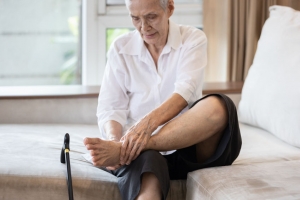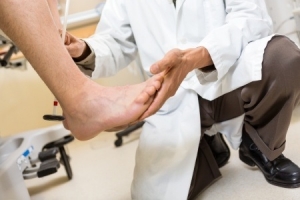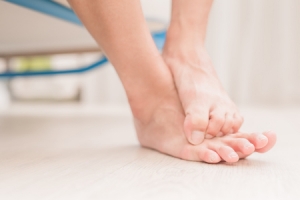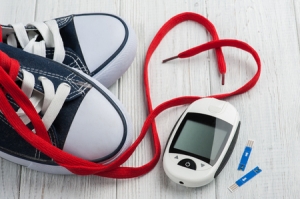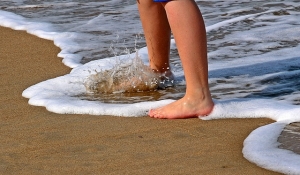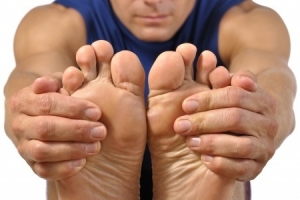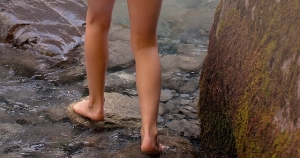Connect With Us
Blogs
Displaying items by tag: athlete's foot
Avoid These 4 Podiatric Pitfalls on Vacation
At Superior Foot & Ankle Care Center we know many of our Los Angeles County patients can’t wait to take a vacation. After a year plus of Covid restrictions, you’ve got places to go and people to see! Our goal is to make sure a painful foot problem doesn’t slow you down. Below are four potential pitfalls you’ll want to avoid on your summer vacation.
- Not Wearing Socks with Sandals—Yes, you read that right. While normally wearing socks with sandals would be a fashion “faux pas,” if your trip starts with an airplane flight it’s highly encouraged. Most security checks require you to remove your shoes. Every person who walks with bare feet through the scanner machine has the potential to leave behind bacteria or fungi that can result in athlete’s foot, fungal toenails or another infection which are passed on by direct contact for the people who follow them.
- Getting New Shoes for Vacation—It’s great to find the perfect pair of shoes to go with your new shorts and sundresses, but packing them before wearing them can be a big mistake. Even though you should always try on both shoes when purchasing and spend some time in the store walking around, new shoes can still surprise you with blisters or rubbing in places you didn’t expect. Try them out at different times (your feet are largest and most swollen at the end of the day) for a day or two before you go to make sure they are comfortable and pain-free.
- Being a Bare-Foot Beach Bum—With the sun beating down on it, the sand at the beach can heat up to over 100 degrees F. Even a few steps from the parking area to your beach blanket can result in dangerous blistering burns to the soles of your feet. If you like to take walks on the beach, a pair of water shoes can also help you avoid sharp objects that can cause puncture wounds and other hazards like jellyfish that have washed up on the shore.
- Forgetting to Pack Foot Care Essentials—Even if you’re only traveling with a carry-on bag you should have room for a few small items that can make a big difference in foot comfort while on vacation. If our podiatrists, Victoria M. Foley and Dr. Constance Ornelas, have prescribed a custom orthotic, don’t leave it home! It’s also a good idea to bring moleskin to prevent painful blisters, foot powder, nail clippers, and an emery board.
We hope you and your family have a great vacation this summer. If you find a foot or ankle is hurting you when you return, or you notice other unusual symptoms in your feet, be sure to contact our Long Beach office at (562) 420-9800 office promptly for an appointment.
5 Foot Care Tips for Seniors
Did you know that the average person walks between 2.5 and 5 miles a day? At Superior Foot & Ankle Care Center we know that means our Los Angeles County senior patients have likely put quite a few miles on their feet. In honor of Older Americans Month 2021, we’d like to offer some tips for protecting podiatric health as you age.
- Listen to your feet. Foot pain, shoes that don’t seem to fit properly anymore, and fatigue in your legs or feet are all ways that your feet communicate that something isn’t right. Don’t put off seeking an evaluation of these symptoms. Contact our Long Beach office at (562) 420-9800 to schedule an appointment with our podiatrists, Victoria M. Foley and Dr. Constance Ornelas.
- Keep feet clean and dry. Wash daily with soap and water and dry thoroughly (paying particular attention to the spaces between your toes). If you tend to sweat excessively, keep an extra pair of socks with you and change when you notice your feet feel damp. This will go a long way in preventing fungal infections like athlete’s foot and toenail fungus.
- Check your feet daily. Look over your entire foot (or ask someone to do it for you) for any unusual changes. Toenail or skin discoloration, bumps, bruises and swelling may all indicate a developing foot or even systemic problem. Diseases such as diabetes, hypertension and arthritis often first manifest in the feet.
- Choose shoes wisely. Your footwear is one of the biggest predictors of podiatric health. Look for styles that have good arch support and heel and insole cushioning. Treads should be non-slip but not have rubber over the toes which can lead to tripping. Ask the podiatrist for recommendations of shoe styles if you have a deformity such as a bunion or hammertoe. Lastly, get your feet professionally measured to ensure a proper fit and always try on both shoes before purchasing.
- Reduce fall risk. Falls are the number one cause of both fatal and non-fatal injuries in seniors. Safeguard your home by installing additional stair rails and lighting. Remove throw rugs, plant stands, electrical cords that are across walking areas, and other clutter to lower your chances of falling.
Your podiatrist is your partner in making sure your feet continue to be healthy and enable you to keep on living the active life you love. If you have any questions or concerns, don’t hesitate to contact us.
8 Ways to Protect Your Feet if You Have Diabetes
November is American Diabetes Month and at Superior Foot & Ankle Care Center this is a topic of high importance. Diabetes has the potential to seriously impact the health of your feet. When blood sugar levels are high, your immune system can be compromised, and your body may have difficulty fighting infections. Two other conditions associated with diabetes—poor circulation and peripheral neuropathy (loss of feeling) — can conspire to put your feet at risk for dangerous wounds and infections. Diabetes can also affect your bones, joints, and skin. This year’s message from the American Diabetes Association, however, is one of hope: “We Stand Greater Than Diabetes.” The good news is that there are many ways to prevent podiatric problems if you have diabetes. Below are eight to consider:
- Schedule regular podiatric exams. Our podiatrists, Victoria M. Foley and Dr. Constance Ornelas, are an important part of your health care team if you have diabetes. Seeking care regularly will help the foot doctor spot problems before they get out of control and help you be proactive in protecting your feet.
- Check your feet daily. Getting in the habit of examining your feet—top, bottom, between the toes and toenails—will enable you to spot any changes promptly. Cuts that aren’t healing, redness, swelling, bruising, growths, or changes in skin color or nails may all be signs that something potentially harmful is developing. Any changes should be reported promptly to our Long Beach office by calling: (562) 420-9800.
- Choose your shoes carefully. Avoid stiff shoes and look for styles that have roomy toe boxes. Get your feet measured and fitted professionally and periodically run your hand around the inside of the shoes to make sure there are no rough seams or material that could cause friction and blisters.
- Don’t smoke. It impedes circulation.
- Keep feet dry. Sitting in damp footwear can increase your risk of athlete’s foot and fungal toenails.
- Don’t go barefoot. Even at home, wear slippers or shoes to prevent cuts and puncture wounds.
- Do not use medicated pads, acid solutions, or sticky pads. For warts, corns, and calluses consult your podiatrist for treatment and don’t attempt any “bathroom surgeries.”
- Follow your doctor’s instructions for managing your diabetes. Take your medications as directed, eat a nutritious diet, maintain a healthy weight, and exercise regularly.
Foot Disorders that Sound Scary (but Aren’t!)
At Superior Foot & Ankle Care Center we thought we’d get into the spirit of Halloween for our Los Angeles County patients by exploring some foot problems that have frightening names. If our podiatrists, Dr. Victoria M. Foley and Dr. Constance Ornelas told you that you had one of the disorders named below, you might panic. But in reality, these are just the medical names for some fairly common and easily treatable conditions. And, our friendly podiatrists would most likely tell you the “user-friendly” name of your foot problem to avoid alarming you!
Tinea Pedis—You’d probably be less scared if you heard “athlete’s foot,” the common name for this itchy skin problem. Often beginning between your toes, the skin will be red, itchy, and flaky. In advanced cases, oozing blisters and cracks in the skin may develop. There are a number of topical treatments that the foot doctor may prescribe to eliminate athlete’s foot. Of course, it’s better to avoid contracting it in the first place. To prevent athlete’s foot, wear shower shoes when walking in public places like community pools and gyms, avoid items that touch another person’s foot, and keep feet dry.
Medial Tibial Stress Syndrome—You may experience this podiatric problem if you’ve recently started a new walking or running program. Its shorter name is “shin splints.” Telltale signs include pain, swelling, and tenderness in the front of the leg on either side of the shin bones. It’s important that you have your legs and feet examined by the foot doctor if you have shin splints because there are a number of different causes of this condition. Left untreated, the pain will get worse and may even lead to a stress fracture.
Onychomycosis—What does it mean when your toenails become discolored and get thick and crumbly? Most likely you’ve contracted toenail fungus—also known as onychomycosis. Fungal toenails are harder to get rid of than other fungal infections. The foot doctor will prescribe the best treatment option for you. We also offer KeryFlex Nail Restoration System to repair nails damaged by fungal infections.
We don’t ever want any of our patients to be fearful about seeing the podiatrist. If you notice anything that looks even a little frightful about your toes, feet or ankles make an appointment at our Long Beach office today by calling: (562) 420-9800.
3 “Frightening” Foot Diagnoses
At Superior Foot & Ankle Care Center, we strive to make your podiatric visits as non-scary as possible. Certain foot problems, however, have names that sound quite frightening, but in reality, are fairly common and easily treated. Below are three that might cause you to be alarmed:
Subungual hematomas—not only does this condition sound gruesome, its appearance may give you a scare as well. Its telltale sign is a black toenail. No plague here, however. The black color of the nail is caused by blood pooling under the nail—most often the result of an injury to the toe, like a bad stubbing or a heavy object falling on your foot. Black toenails are also a frequent occurrence among patients who are runners. The repetitive pounding of the toes up against the front of the shoe can result in black nails. In most cases, subungual hematomas will clear up on their own. You might want to get your feet measured to make sure you are wearing shoes that are big enough for your feet.
Onychomycosis—this ten-dollar term is another way of saying you have toenail fungus. Although you may feel that your toe looks like it belongs in a horror movie—discolored, edges that are crumbling and breaking off and odd spots on the nail—fungal nails are often not painful at all. In fact, that’s partly why patients don’t bother getting them evaluated. Fungal infections can spread to other toes and other parts of the body, however, so it’s best to have our podiatrists, Dr. Victoria M. Foley or Dr. Constance Ornelas evaluate a funky looking nail and prescribe the best treatment.
Tenia pedis—you probably know this condition better by its more common name, athlete’s foot. This common foot fungus can be unbearably itchy and cause a red rash, flaky skin and even oozing blisters if left untreated. You get athlete’s foot by coming in direct contact with the fungi and most cases can be prevented by keeping your feet covered in public places and not sharing socks, shoes, or other items that touch another person’s feet.
No matter how bizarre your podiatric symptoms may be, the best course of action is to contact our Long Beach office for an appointment as soon as possible by calling: (562) 420-9800.
Facts about Psoriasis
During the month of August, we at Superior Foot & Ankle Care Center recognize Psoriasis Action Month. Psoriasis can appear on your legs and feet as well as on other parts of your body. Below are some facts about this condition and what can be done about it.
FACT: Psoriasis is a chronic disease of the immune system. It manifests most often as a skin condition. In people with psoriasis, new skin cells come to the surface too rapidly. This results in an inflammation of the skin.
FACT: It’s estimated that 8-12 million Americans currently suffer from psoriasis.
FACT: Psoriasis often first develops in patients between the ages of 15 and 25, but can strike at any age.
FACT: Researchers believe that the cause of psoriasis is a combination of an inherited genetic tendency for the disease combined with exposure to certain external triggers. Several possible triggers have been identified, including stress, certain medications, an injury or infection. Triggers are not the same for each person.
FACT: There are multiple types of psoriasis and they can appear differently on the skin. Thick patches of skin, redness, blisters, and lesions are some of the possible symptoms. Psoriasis may cause itching and pain.
FACT: Psoriasis can also cause inflammation and pain in your joints, tendons, and ligaments. About one in three patients with psoriasis develop psoriatic arthritis.
FACT: Patients with psoriasis are at an elevated risk for contracting other conditions like cancer, cardiovascular disease, depression, osteoporosis, liver disease, diabetes, and more.
FACT: On your feet and toenails, psoriasis may look like athlete’s foot or fungal toenail infection. For this reason, if you notice any unusual changes in your skin or toenails or you are experiencing unexplained joint pain, contact our Long Beach office by calling: (562) 420-9800 for an appointment. Our podiatrists, Dr. Victoria M. Foley or Dr. Constance Ornelas will examine your feet and determine whether an infection, psoriasis or some other disorder is the source of your discomfort.
6 Tips for Protecting Your Feet with Diabetes
At Superior Foot & Ankle Care Center, we know that diabetes can affect your skin, joints, and bones in a number of ways. Two conditions associated with the disease—peripheral arterial disease (PAD) and neuropathy—are of particular concern when it comes to your lower extremities. PAD is a narrowing or blocking of the arteries to your legs, which can lead to poor circulation. This means that nutrient and oxygen-rich blood necessary for healing cannot reach your legs, feet, and toes as quickly as needed. Neuropathy is nerve damage that can result in loss of feeling in your feet, which makes it difficult to perceive pain and injury. This double whammy means that patients with diabetes are at a higher risk for a host of podiatric problems, including:
- Ulcers and wounds that do not heal properly
- Fungal infections
- Hammertoes
- Ingrown toenails
- Corns and calluses
Difficulty healing can cause even minor foot and toe problems to become major threats with the potential for infection and even amputation. Below are some ways you can be proactive in preventing foot problems if you have diabetes:
- Control your blood sugar. Follow all your doctor’s instructions for managing your diabetes. Watch your diet, take your medications as directed and regularly test to make sure you are on track.
- Schedule regular podiatric checkups. Our podiatrists, Victoria M. Foley or Dr. Constance Ornelas, will work with you to prevent potentially dangerous foot issues. Seeing the foot doctor regularly will increase the chances of catching injuries and infections in their very early and most treatable stages. The podiatrist can also help with nail care, wound debridement and diabetic footwear and orthotics.
- Keep feet clean, warm, and dry. Wash daily and dry thoroughly—especially between your toes. Use a foot powder before putting on socks.
- Make sure shoes fit correctly. Avoid styles that have narrow toe boxes are that are made of very stiff materials. Keep the heel height to 2 inches or less.
- Don’t walk barefoot. This dramatically increases your chances of getting athlete’s foot or a fungal toenail infection, which are contracted by direct contact. You are also more likely to step on a sharp object and injure your foot without shoes.
- Conduct regular self-exams—it’s important that between appointments you are checking your feet and toes daily for any signs of rashes, cuts, blisters, bruises, growths or other indicators that a foot problem is developing. If you can’t see your whole foot as a family member or caregiver to assist you. Contact our Long Beach office immediately by calling (562) 420-9800 if you find anything concerning.
Beach Day or Bust?
At Superior Foot & Ankle Care Center, we know that many of our patients like to relax by spending a day at the beach. However, besides rain, nothing ruins a beach day faster than a foot or ankle injury. Below are some easy ways to avoid foot trouble and enjoy some fun in the surf and sand.
Watch out for Jellyfish—a dead jellyfish that has washed up on the shore through its tentacles can still sting you. If this happens, use gloves to protect your hands and gently remove the tentacles. Apply vinegar or baking soda to help the pain and swelling decrease.
Wear Flip Flops—this is one of the few times that you will hear us recommend flip-flops, but for a beach day, they can help your feet in several ways:
- Getting from the car to your beach blanket, they will prevent the soles of your feet from being burned by the hot asphalt or the sand that’s been baking in the sun.
- For walks on the beach, flip-flops can protect your feet from cuts from sharp shells and puncture wounds from debris hidden in the sand.
- When using the changing area or restroom, flip-flops will keep you from coming in contact with bacteria, viruses, and fungus that cause athlete’s foot, warts, and other
Re-Apply Sunscreen—a water-resistant sunscreen that has an SPF of 15 or higher should be used on the tops and bottoms of your feet if you are laying out on the beach. To be effective in preventing sunburn, it needs to be reapplied every two hours, and after each time you take a dip in the ocean.
Bring Sneakers—if beach volleyball, Frisbee or other active games are part of your idea of fun at the shore pack sneakers in your beach bag. Wearing flip-flops or playing barefoot can increase your risk for an ankle sprain in the shifting sands.
Remember Your Water Bottle—drinking lots of water is not only essential for staying hydrated, it helps you avoid swelling of the ankles and feet which can be painful and make it difficult to fit into your shoes for the ride home.
If your beach day results in an injury, rash or other foot or ankle symptoms, make an appointment at our Long Beach office (562-420-9800) promptly so that our podiatrists, Dr. Victoria M. Foley or Dr. Constance Ornelas can examine your feet and treat any podiatric problems.
4 Common Foot Problems for Men
June is a month for celebrating men! At Superior Foot & Ankle Care Center, we want to recognize Men’s Health Month by highlighting some foot infections that afflict men. Studies show that men are less likely to be proactive and diligent about getting medical care. Encourage the men you love to get foot problems treated promptly by our podiatrists, Dr. Victoria M. Foley or Dr. Constance Ornelas. Below are some common podiatric issues men face.
- Haglund’s Deformity—while this condition, known as “pump bump,” it frequently affects men as well as women. Haglund’s deformity is a bony enlargement at the back of the heel that can become inflamed and irritated from the friction of stiff dress shoes and other footwear rubbing up against it. Bursitis can also develop because of Haglund’s deformity. The foot doctor will recommend shoe modifications, including changes in style and heel lifts or pads to help reduce friction. Icing and anti-inflammatory medications may be prescribed to relieve initial pain and inflammation.
- Gout—this painful, arthritic condition that usually strikes the joint at the base of the big toe is seen most often in men, ages 40-60. It is caused by too much uric acid in the body, which crystallizes in the joint. There are several potential sources of gout, and the podiatrist will help men who have suffered a gout attack before tracking down the cause. In many cases, certain foods can trigger an attack, and gout patients may need to avoid shellfish, red meat, alcohol, and rich sauces.
- Fungal Infections—regular exercise is a key component of a healthy lifestyle, but if the gym or community pool is the work site of choice, it’s essential to keep feet covered to avoid fungal infections like athlete’s foot and fungal toenails. These are passed on by direct contact. Places where people usually are barefoot and that are moist and warm are prime breeding grounds.
- Plantar Fasciitis—one of the most frequent causes of heel pain is plantar fasciitis. The plantar fascia is a long band of tissue that stretches along the bottom of your foot. If it becomes inflamed, heel pain may result. Flat feet and poorly fitting or worn out shoes are one common cause of inflammation.
Encourage your man not to ignore foot and ankle pain. Instead, make an appointment at our Long Beach office today by calling: (562) 420-9800 and get treatment before the problem worsens.
Avoid Summer Foot Hazards
During the summer months your feet experience some particular challenges. At Superior Foot & Ankle Care Center we want to alert our patients to some potential foot and ankle problems and ways to prevent them.
Puncture Wounds and Cuts—going bare foot increases your risk of stepping on a sharp object. If this does happen and you sustain a puncture wound or cut be sure to clean it out completely and apply an antibiotic ointment and a bandage. Avoid swimming in lakes or the ocean while the wound remains open to prevent an infection from developing. If the area around the wound starts to feel warm or you notice redness or any pus or discharge, contact our Long Beach office immediately by calling: (562) 420-9800. Our podiatrists, Dr. Victoria M. Foley or Dr. Constance Ornelas will examine your foot and determine if you need treatment.
Fungal Infections—athlete’s foot, fungal toenails and warts are among the bacterial and fungal infections that are spread by direct contact. For this reason, we recommend keeping your feet covered in public places like community pools, gym locker rooms and showers and the nail salon.
Heel Pain—if flip-flops are your summer go-to shoes, you may notice an increase in heel pain. The average pair of flip-flops provides no arch support. Flattening of the arch exerts more pressure on your heel. If this is your footwear of choice, invest in a pair designed with sturdy soles and built in arch support.
Ankle Sprains—unfortunately many other summer shoe styles are also lacking in side, ankle and arch support. While these may be fine for dinner out or a special occasion, be sure not to wear them for extended periods of walking or sports activities as this likely to result in an ankle twisting injury.
Fortunately, a little common sense and smart choices can go a long way toward protecting your feet this summer. If you have foot pain or discomfort, don’t hesitate to contact us for an appointment.

